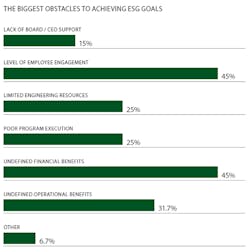Editor's Note: This post was sponsored by Augury
Plant Services, in partnership with Augury surveyed readers about Environmental, Social and Corporate Governance (ESG) policies and practices earlier this year. The survey explored company policies, practices and perceptions about ESG and personal engagement by employees on these issues.
Plant Services talked with retired Global Chief Engineer and industry executive Dave Penrith about the survey for his real-world perspective on the numbers. Penrith spent his 35-year career at a global consumer goods company. During his tenure there, he oversaw 300 factory units across all parts of the world. Penrith is a champion of digital technology, deploying automation and robotics on thousands of applications, and he is also known for his dedication to collaboration, community, and diversity.
Q: According to the survey, the majority of companies (about 46%) indicated that ESG goals and objectives are taken very seriously. Does that number, or the 19% that say that ESG goals are not a priority, surprise you, or does that confirm what you know to be true about industry and ESG?
A: Yes, it does surprise me a little. I really believe everyone will need to have a clear plan in these areas sooner or later. Those that choose to be more on the leading edge in this ESG space, I think they can get a competitive advantage as customer or consumer demand grows for this.
And they can have more influence on the legislation that will inevitably come. I don’t think governments understand the detail as well as industry does, so any ill-informed legislation can be potentially damaging for some industries.
My belief is that being part of defining that end game is better than becoming a victim of it.
Q: In terms of employee engagement with ESG policies, the survey showed high numbers of employees that were unengaged on a daily basis with ESG policies. This shows a discrepancy between what companies outline as their ESG goals and what practices are actually carried out. What do you think is accounting for this discrepancy?
A: I think we’re getting into some age-old problems. ESG is relatively new, but it faces some of the problems that we face in any change. I’d imagine that when most employees look at a list of corporate policies, they’re probably thinking, “How does this really affect me on a daily basis?” So it’s about making it more personal and how it benefits them and also how it benefits them outside of the work environment as well.
I think the second area is the age-old challenge in larger companies or in growing companies. How did you keep a constant and valuable dialogue between the leadership and the people? It’s about how can you engage with your people on a regular basis and how do you make it personal for them? By investing in people’s awareness in this space, you don’t just engage them on the issues, I believe you actually release a lot of the answers that maybe you’re looking for because they can be found in your people. You know the old saying: if only large companies knew what they already know. The trick is releasing all that knowledge and capability out of the people.
Q: It’s clear from the data that something is getting in the way of some companies achieving those ESG goals. Survey respondents indicated employee engagement levels, undefined financial benefits, and undefined operational benefits as obstacles to achieving ESG goals. What do you think those obstacles indicate about opportunities for organizations when it comes to communication and information access at all the levels?
A: We spoke about employee engagement already, so let’s take the operational benefits first and something simple like asset and process performance as the example. If you can ensure that an asset is running in a known and healthy state, or a process is operating in its optimum window, then the benefits are clear at the shop floor level because you’ve got optimum use of resources for the maximum possible output. I always found that the operating teams on the shop floor are in a lot better place when the assets are running well.
On the financial side, it’s really clear that efficient use of resources and maximizing your yield has got clear financial benefits. But another area that I think sometimes goes forgotten is, what does predictable performance give you, if you can get an asset to produce reliably and consistently? Then, you don’t lose the time constantly replanning and rescheduling.
People cost is another area. When people are happy and engaged and productive in this, those people are retained. Losing people and rehiring people is a costly exercise. A lot of the newer generations have additional motivations these days. They don’t want just a job; they want a career where they can gain experiences and also more important, they can actually make a difference. Adopting some of those newer approaches in this area is a key motivator for a lot of our workforce nowadays. We need those people engaged because they’re the ones that are going to build our future for us.
Q: There are many new technology solutions available that are helping companies with ESG goals. According to our survey, the majority of companies are already using energy monitoring technology followed by leak detection and emissions monitoring and asset monitoring and analytics solutions. So where can companies benefit from technology solutions?
A: I think the trick is having a bit of connected thinking. If you look at leak detection, for example, in isolation, all it tells you is how bad it is. It’s a single dimension and one-off data point. It’s great, but it doesn’t prevent the issue from reoccurring. I think if you build in asset monitoring analytics, you start being able to drive toward the root cause and prevent it from happening again. If an operator could visualize their own data in a slightly different way, it engages them around it, and then you bring them on-board because they’ve got more knowledge than anybody else.
Q: Even the most advanced digital solutions need those engaged employees in order to make them really work on the plant floor. Can you talk a little bit more about the people side of technology? What have you seen in the field when it comes to introducing new tech or insights about what works to get people not only enthusiastic about technology solutions but also committed to results?
A: I think most human beings first reaction is to resist change. I think people have a built-in inertia along the direction that they’re already moving in, so in order to get that changed they really need to trust it and believe that. The change is also going to be seen as an investment in them personally.
One area is upgrading people’s skills because as these things come on, you’re going to need different skills. So, lean into that early on rather than wait for it to happen, because that makes it a positive experience rather than a reactive one. And that’s also part of investing in the people’s future and removing their fear of it. That helps them be a part of the momentum of change and not casualty of it.
And as I’ve said previously, many of the answers that people are searching for could already be in there, and that more inclusive approach is one of the ways you can really help release them. It is the human touch that’s absolutely crucial.
This story originally appeared in the October 2022 issue of Plant Services. Subscribe to Plant Services here.


